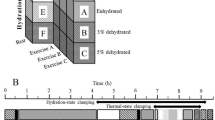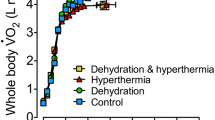Summary
Two aspects of the recovery period after endurance exercise were investigated: a) the fluid distribution between the intra- and extravascular parts of the extracellular fluid volume (ECFV) induced by exercise dehydration, b) the cardiovascular response pattern [blood pressure (BP), heart rate (HR), cardiac output (CO), total peripheral resistance (TPR), and central venous pressure (CVP)] to the heat load which results from the preceding exercise.
Seven conscious dogs performed endurance exercise in a cool environment (16°C) on a horizontal treadmill till 4% of the body weight was lost. It was found that about 70% of the total fluid loss of the body came from intracellular water. During exercise sodium and chloride concentrations rose by 6 mMol and 7 mMol respectively (P<0.005) and remained elevated throughout the early recovery period indicating a fluid loss of about 100–200 ml out of the ECFV. Direct measurements of the ECFV as sulfate space confirmed these values. Since the plasma volume remained unchanged, this fluid loss was carried totally by the interstitial fluid volume.
Immediately after exercise body temperature was elevated by 1.5°C and returned towards control within 90 min. Cardiac output was above control level for 2 h after the end of exercise, at first due to an increased HR and thereafter to an elevated stroke volume (SV) (P<0.02). CVP and TPR were below control levels for at least 2 h (P<0.01). A linear correlation was found between CVP and TPR.
A close correlation existed between the body temperature and the cardiovascular parameters. It can be concluded that even long after exercise the cardiovascular system has to serve thermoregulatory needs.
Similar content being viewed by others
References
Adolph, E. F.: Blood changes in dehydration. In: Physiology of man in the desert (M. B. Visscher, D. W. Bronk, E. M. Landis, and A. C. Ivy, eds.), p. 160. New York-London: Hafner Publishing Company 1969
Åstrand, P.-O., Rodahl, K.: Textbook of work physiology. New York-St. Louis-San Francisco-London-Sydney-Toronto-Mexico-Panama: McGraw-Hill Book Company 1970
Åstrand, P.-O., Saltin, B.: Plasma and red cell volume after prolonged severe exercise. J. appl. Physiol.19, 829–838 (1964)
Bevegård, B. S., Shepherd, J. T.: Changes in tone of limb veins during supine exercise. J. appl. Physiol.20, 1–8 (1965)
Bevegård, B. S., Shepherd, J. T.: Reaction in man of resistance and capacity vessels in forearm and hand to leg exercise. J. appl. Physiol.21, 123–132 (1966)
Bevegård, B. S., Shepherd, J. T.: Regulation of the circulation during exercise in man. Physiol. Rev.47, 178–213 (1967)
Brown, M. E.: Sugar determinations using 2,9-dimethyl-1,10 phenanthroline hydrochloride (Neocuproine). Diabetes10, 60–62 (1961)
Costill, D. L., Fink, W. J.: Plasma volume changes following exercise and thermal dehydration. J. appl. Physiol.37, 521–525 (1974)
Cowgill, G. R., Drabkin, D. L.: Determination of a formula for the surface area of the dog together with a consideration of formulae available for other species. Amer. J. Physiol.81, 36–61 (1927)
Gauer, O. H., Henry, J. P.: Circulatory basis of fluid volume control. Physiol. Rev.43, 423–481 (1963)
Hammel, H. T., Wyndham, C. H., Hardy, J. D.: Heat production and heat loss in the dog at 8–36° C environmental temperature. Amer. J. Physiol.194, 99–108 (1958)
Hultman, E.: Physiological role of muscle glycogen in man, with special reference to exercise. Circulat. Res.20/21, Suppl. I, 99–114 (1967)
Kaufmann, W., Hundeshagen, H., Schlitter, J. G., Graul, E. H.: Die Regulation des Herzzeitvolumens bei thermischer Belastung in der Klimakammer. Arch. physik. Therap.12, 176 (1960)
Kirsch, K., Risch, W.-D., Mund, U., Röcker, L., Stoboy, H.: Low pressure system and blood volume regulating hormones after prolonged exercise. In: Metabolic adaption to prolonged physical exercise (H. Howland and J. R. Poortmans, eds.), pp. 315–321. Basel: Birkhäuser 1975
Kirsch, K., Schultze, G., Röcker, L., Bierbaum, U., Eckert, P.: The effect of exercise and dehydration on plasma volume and central venous pressure. Z. Kardiol.62, 49–58 (1973)
Kozlowski, S., Saltin, B.: Effect of sweat loss on body fluids. J. appl. Physiol.19, 1119–1124 (1964)
Öberg, B.: The relationship between active constriction and passive recoil of the veins at various distending pressures. Acta physiol. scand.71, 233–247 (1967)
Olsson, K. E., Saltin, B.: Variation in total body water with body glycogen changes in man. Acta physiol. scand.80, 11–18 (1970)
Phillips, H. H., Jennings, D. B.: Cardiorespiratory effects of hypothalamic heating in conscious dogs. Amer. J. Physiol.225, 700–705 (1973)
Pruett, E. D. R.: Glucose and insulin during prolonged work stress in men living on different diets. J. appl. Physiol.28, 199–208 (1970)
Pugh, L. G. C. E.: Blood volume changes in outdoor excercise of 8–10 hour duration. J. Physiol. (Lond.)200, 345–351 (1969)
Rowell, L. B.: Cardiovascular limitations to work capacity. In: Physiology of work capacity and fatique (E. Simonson, ed.), pp. 132–169. Springfield, Ill.: Ch. C. Thomas 1971
Rowell, L. B.: Human cardiovascular adjustments to exercise and thermal stress. Physiol. Rev.54, 75–159 (1974)
Ryan, R. J., Pascal, L. R., Inoye, T., Bernstein, L.: Experiences with radiosulfate in the estimation of physiologic extracellular water in healthy and abnormal man. J. clin. Invest.35, 1119–1130 (1956)
Saltin, B.: Aerobic work capacity and circulation at exercise in man. Acta physiol. scand.62, Suppl. 230 (1964)
Schneider, K. W., Rost, R., Gattenlöhner, W.: Kreislauffunktion beim Sportler. Hämodynamische Untersuchungen mit der Indikatorverdünnungsmethode. Stuttgart-New York: F. K. Schattauer 1970
Senay, L. C., Jr.: Changes in plasma volume and protein content during exposures of working men to various temperatures before and after acclimatization to heat: separation of the roles of cutaneous and sceletal muscle circulation. J. Physiol. (Lond.)224, 61–81 (1972)
Shepherd, J. T.: Behavior of resistance and capacity vessels in human limbs during exercise. Circulat. Res.20/21, Suppl. 1, 70–82 (1967)
Skeggs, L. T., Jr., Hochstrasser, H.: Multiple automatic sequential analysis. Clin. Chem.10, 918–936 (1964)
Stegemann, J., Kenner, Th.: A theory on heart rate control by muscular metabolic receptors. Arch. Kreisl.-Forsch.64, 185–214 (1971)
Wyndham, C. H.: The physiology of exercise under heat stress. Ann. Rev. Physiol.35, 193–220 (1973)
Author information
Authors and Affiliations
Additional information
This study was supported by the Bundesinstitut für Sportwissenschaften Köln and
the Deutsche Forschungsgemeinschaft
Rights and permissions
About this article
Cite this article
Kirsch, K., Hrynyschyn, K., v. Ameln, H. et al. Extracellular fluid volume and central circulation after long lasting exercise and dehydration in conscious dogs. Pflugers Arch. 368, 209–215 (1977). https://doi.org/10.1007/BF00585198
Received:
Issue Date:
DOI: https://doi.org/10.1007/BF00585198




